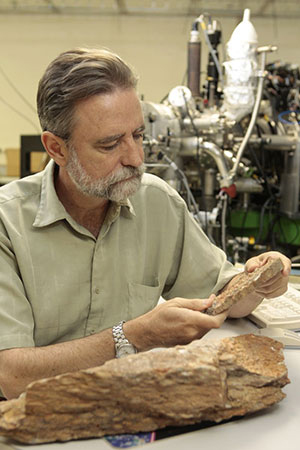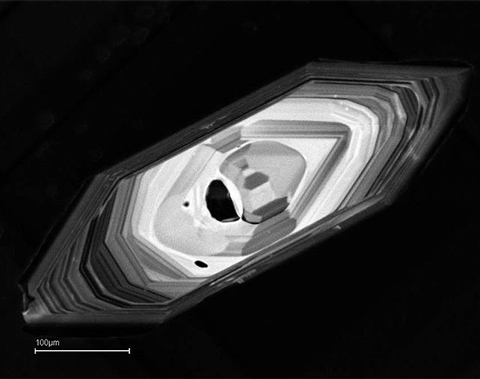Study Finds Potential Evidence of Life 4.1 Billion Years Ago
Scientists from the Department of Earth, Planetary, and Space Sciences, University of California, (Los Angeles), in collaboration with colleagues from the School of Earth, Energy, and Environmental Sciences, Stanford University, also in California, have published research that suggests that life on Earth may have existed as far back as 4.1 billion years ago.
A remarkable claim considering that our planet is believed to be around 4.54 billion years old. This new research hints at life evolving some 300 million years earlier than previously thought, although the evidence of these claims is likely to be disputed.
New Paper Published
The study has just been published in the on line edition of the academic journal “Proceedings of the National Academy of Sciences”. The team identified graphite (a form of carbon), trapped inside a single ancient zircon crystal in a stud of these ancient time capsules from the some of the oldest rocks known on Earth, strata found in Western Australia. The carbon form identified is one that is associated with the process of photosynthesis, therefore, this could be a by-product of a life process.
Co-author of the research, Professor Mark Harrison (University of California, Los Angeles) stated:
“Twenty years ago, this would have been heretical, finding evidence of life 3.8 billion years ago was shocking. Life on Earth may have started almost instantaneously, with the right ingredients life seems to form very quickly.”
Professor Mark Harrison (University of California, Los Angeles)
Picture credit: University of California, Los Angeles
Important Implications
One of the implications of this new study is that if life forms very quickly, then the possibility of it forming elsewhere in the universe, under the right conditions, is dramatically increased. Life in the universe could be abundant.
The scientists came to their conclusion after analysing more than 10,000 zircons – heavy, durable crystals, which had formed from molten rock in Western Australia (the Jack Hills area). An earlier study (2008), identified carbon captured in the zircon crystals as they formed. These were dated to around 3.8 billion years ago, at the time this was thought to be the earliest time that life could have begun on our planet.
Around 100 million years early, the inner solar system had been subjected an intense bombardment from asteroids and other space debris left over from the formation of the planets.
The Late Heavy Bombardment (LHB)
This is called the Late Heavy Bombardment (LHB) and is believed to have lasted until around 3.9 billion years ago. It was this bombardment that created most of the craters on the moon. These craters are still visible today. This study suggests that life existed on our planet before these moon craters were formed.
Co-author of the research paper, Patrick Boehnke, a graduate student in the Department of Earth, Planetary and Space Sciences (University of California, Los Angeles) explained:
“If all life on Earth died during this bombardment, which some scientists have argued, then life must have restarted quickly.”
Looking for Evidence Preserved in Deep Time
The scientists, led by Elizabeth Bell, (postdoctoral student, at the University of California, Los Angeles), examined more than 10,000 zircons. Of the zircons included in this study, 656 were identified as containing dark specks preserved inside their structure. These minute particles were captured when the zircon was formed, trapping and recorded evidence of the extremely ancient Earth. Ramon spectroscopy was used to analyse the molecular and chemical structure of these dark specks, the team were looking for pure carbon, one of the building blocks of life.
One of the zircons contained two areas of graphite, a form of pure carbon. Graphite was found in two locations within the zircon crystal.
Dark Specks Inside A Zircon Crystal Identified as Carbon
Picture credit: University of California, Los Angeles
Life on Earth
Stating that the team were confident that the carbon is evidence of biological activity and that the graphite formed due to biological activity, Professor Harrison said:
“There is no better case of a primary inclusion in a mineral ever documented and nobody has offered a plausible alternative explanation for graphite of non-biological origin into a zircon.”
According to the researchers, the graphite is actually older than the zircon containing it. The isotope ratio between the uranium and lead indicates that the zircon itself is 4.1 billion years old, but for the moment they do not know how much older the graphite might be.
Could Life in the Universe be Abundant?
The research suggests life in the universe could be abundant, Professor Harrison concluded. On our planet, the third rock from the sun, simple life appears to have formed quickly, but it likely took many millions of years for very simple life to evolve the ability to photosynthesise. Yet the carbon contained in the zircon has a very characteristic chemical signature. The specific ration of carbon 12 to carbon 13 isotopes is evidence of photosynthesis having taken place on the early Earth.
In July, Everything Dinosaur published an article about research that suggested the Earth’s magnetic field formed earlier than previously thought: Our Magnetic Shield is Older than Previously Thought.
In 2014, Everything Dinosaur reported on research that suggested that the Earth cooled more rapidly than earlier studies had suggested: The Earth Cooled Earlier Than Previously Thought.








Leave A Comment